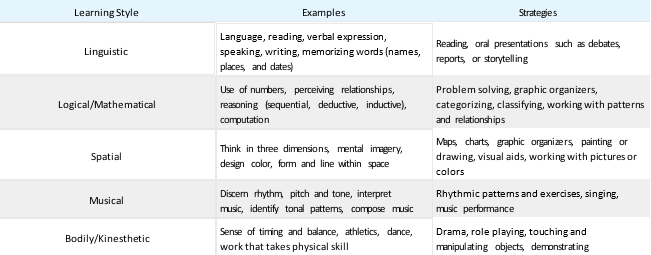Learning Objectives
Define the concepts of multiple intelligences and learning styles, and identify different types of intelligence and learning styles that audience members may have.
Psychologist Howard Gardner is known for developing the theory of multiple intelligences, which he proposes is that different people are intelligent in different domains. For example, some people may excel in interpersonal intelligence or the ability to form and maintain relationships. Other people may excel in bodily-kinesthetic intelligence or physical coordination and control. Still, others have a high degree of musical intelligence or logico-mathematical intelligence. While some psychologists argue that these are talents or aptitudes rather than forms of intelligence, the point remains that individual audience members will receive information differently, depending on their intelligence (or talent).
An outgrowth of the theory of multiple intelligences is the theory of learning styles, the idea that people learn better if the message is presented in a strategy that fits with the types of intelligence in which they are strongest. Consider each style when preparing your speech. What styles might work best with your particular audience?
For example, suppose you work for a do-it-yourself home improvement store, and part of your job is to give an informative seminar once a month on how to renovate a previously wallpapered wall. Your topic is specified for you, and you are very familiar with your subject matter, having worked in a variety of homes where old wallpaper needed to be removed or replaced. However, you never know from one month to the next how many people will come to your seminar or their interests and prior knowledge level.
If you begin by going around the room and asking each person to describe the wallpaper situation they plan to work on, this will help you determine what kinds of questions your audience hopes to have answered, but it won’t tell you anything about their learning styles. Suppose instead that you ask them why they decided to attend and their career or occupation. Now, you can gauge your presentation according to the likely learning styles of your audience. For example, if you have ten attendees and five of them work in the banking or information technology field, it is probably safe to assume they are fairly strong in the logical or mathematical area. This will help you decide how to talk about measuring the wall, calculating product quantities, and estimating cost. If another attendee is a psychologist, he or she may be able to relate on the intrapersonal and interpersonal levels. You may decide to strengthen your remarks about the importance of being comfortable with one’s choices for renovating the room, seeking consensus from family members, and considering how the finished room will be suitable for guests. If some attendees work in the arts, they may be especially attentive to your advice about the aesthetic qualities of a well-executed wall surface renovation.
Table 13.4.1 summarizes the seven learning styles and suggests strategies for designing your speech to align with each style.


Key Takeaway
An informative speech can be more effective when the learning styles of the audience members are addressed.
Exercises
List several people you know well, including family members, lifelong friends, or current roommates. Opposite each person’s name, write the types of intelligence or the learning styles in which you believe that person is especially strong. Consider making this a reciprocal exercise by listing your strongest learning styles and asking family and friends to guess what is on your list.
How do you learn best? What works for you? Write a short paragraph and share it with the class.
Write a review of your best teachers, noting why you think they were effective. Then, share it with the class.
Write a review of your worst teachers, noting why you think they were ineffective. Share with the class.
Gardner, H. (1993). Frames of mind: The theory of multiple intelligences. New York, NY: Basic Books.
This page titled13.4: Diverse Types of Intelligence and Learning Styles is shared under a CC BY-NC-SA 3.0 license and was authored, remixed, and/or curated by Anonymous (LibreTexts Staff), from which source content was edited to the style and standards of the Pressbook platform licensed under a Creative Commons Attribution-NonCommercial-ShareAlike 4.0 International License by Brandi Schur.

